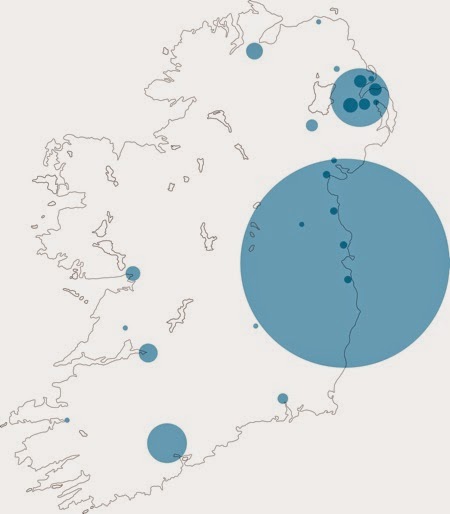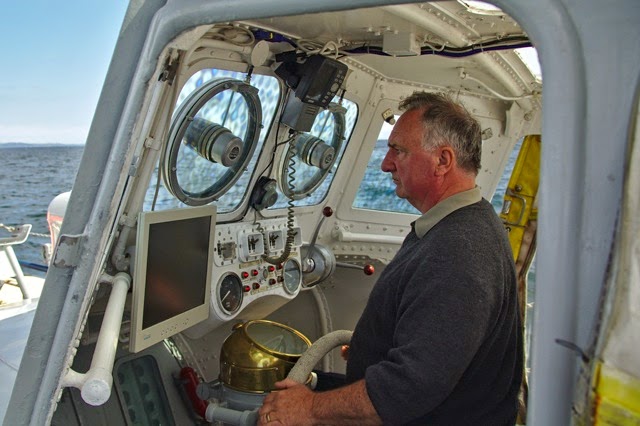
Tuesday, April 28, 2015
Monday, April 27, 2015
Nuance in Northern Ireland
We have lost it.
Nuance that is. There is little or no nuance in public discourse any more. Twitter and phone-in shows have brought war to every issue, where the extremes are deployed against each other. And many spokespeople, public figures and activists relish this opportunity for easy coverage and airtime. And the behaviour of some provides perfect material for programme producers. In the ongoing "culture war" which has been squared up between 'traditional' Christianity and 'progressive' same-sex identity, there seems to be no scope for either to listen.
The irony is that the Gospel says that all have sinned. Sin takes a million forms, but is ultimately always about the self. The Gospel also says that humanity cannot behave its way to right relationship with a holy God. If it could, reverently speaking, then Jesus made a terrible mistake and was wasting His time. He didn't actually need to die and rise again, He just needed to give good advice. And so (liberalised) churches minimise sin and reduce the Gospel to mere moral lessons, and others seem to forget the import of the Gospel and embark upon moralistic campaigns to get society to behave 'better'. But people cannot behave better enough. And sin isn't just our actions, words and motives – it's our very nature. To coin a phrase, we are all born this way. "All have sinned and fallen short", backed up with "For God so loved the world", are the great levellers.
Dr Rosaria Butterfield, an academic and erstwhile lesbian activist, has a fascinating story to tell. And she 'gets' the Gospel in a way that many of us would benefit from. Nuance, intelligence and a proper understanding of the Gospel is a powerful combination. Northern Ireland would benefit from a Rosaria Butterfield.
Reaching Ireland
The most recent calculation of the population of the island of Ireland is 6.4 million, with 4.6 million in the Republic and 1.8 million in Northern Ireland (stats here). Scotland's population is a wee bit less, at 5.3 million.
The largest 25 towns and cities across the whole island are (broadly speaking, using 2011 figures) listed below, with 12 of the 25 in Northern Ireland:
1 Dublin 1,045,769 2 Belfast 276,459 3 Cork 190,384 4 Limerick 90,757 5 L'Derry 83,699 6 Galway 72,729 7 Lisburn 71,465 8 N'abbey 62,056 9 Bangor 58,388 10 Craigavon 57,685 11 Castlereagh 54,990 12 Waterford 49,213 13 Drogheda 35,090 14 Dundalk 35,085 15 Swords 33,998 16 Bray 31,091 17 Ballymena 28,717 18 Newtownards 27,281 19 Newry 27,433 20 Carrickfergus 27,201 21 Navan 24,851 22 Ennis 24,253 23 Coleraine 24,089 24 Tralee 22,744 25 Kilkenny 22,179
(The bold ones are in Northern Ireland.)
So the total 'urban' population on the island is 2.6m people, with 40% of these in Dublin alone.
If you set aside the huge 'skew' of Dublin (as you might do with London in a GB context) the population of the rest of the cities and towns on the island of Ireland totals 1,531,837.
Of this, just over half (799463) are in Northern Ireland. And of the top 12 cities and towns, 7 are in Northern Ireland.
Visually speaking, it looks like this (circles representing size of population, not the physical size of the places).

However, island-wide, this means that around 3.8 million people, 60% of the island's total population, do NOT live in the biggest cities and towns. This is still a largely rural island. Over the years I've worked with Northern Ireland-based food companies seeking to expand into the Republic and to sell products there. A map like this is a fairly good indicator as to where the marketing efforts need to be targeted for maximum return.
But it's also a surprise to see how strong Northern Ireland's towns and cities are when compared with the rest of the island. Working harder in your own back yard is often a simpler task for SMEs than the risk and stretch of expanding to a new location farther from home.
In summary:
1) 40% of the island's population is urban.
2) Just over half of the non-Dublin urban population is in Northern Ireland.
3) Greater Belfast and the towns around it total 577,840, equating to roughly 1/3 of the non-Dublin urban population on the whole island.
I'm sure a professional statistician will have more accurate figures and analysis than these.
Tuesday, April 21, 2015
Quinton Nelson, North Channel Pilot

Probably a dozen or so times every summer I go out fishing with Quinton Nelson from Donaghadee, in his boat 'The Brothers'. My first trip was when I was about 14, with Donaghadee man David McCormick (who has since become one of the world's top deep sea anglers) - our fathers work together and David and I laboured to them during the summer holidays when we were both still at school. David's father Bob re-installed the 17th century Patrick Montgomery coat of arms on a dwelling house on the Craigboy Road, where it had languished in a yard for donkeys years having once graced Patrick Montgomery's orchard-surrounded house that was the first building on the site.
Quinton is a man of many talents, and he often accompanies the open sea swimmers who travel to Donaghadee from around the world every summer to try to swim the 18 miles to Portpatrick. The current record is 9 hours 34 minutes, set by US swimmer and Nike Ambassador Michelle Macy in July 2013. In August 2014, Colleen Mallon from Co. Armagh swam across in 9 hours 56 minutes.
Monday, April 20, 2015
Robert the Bruce and the Isle of Man

This photo is the view down our lane, to the shore. The lane - the Ballyfrench Road - is locally called "Nelly's Brae", after a woman called Nelly who lived in the house at the bottom whose chimney is just visible. The Ormo bread cart used to stop at Nelly's house and the folk who lived further along the road used to go down there to collect their weekly orders. Nelly died having been found at the bottom of an open well - a fate similar to the Scottish poet Robert Tannahill.
The land on the horizon isn't Scotland (which is just out of shot, to the left hand side) but is in fact the Isle of Man.700 years ago the Isle of Man was of major strategic significance to the ambitions of the Bruce brothers:
May 1313: The Isle of Man and a ‘preliminary raid’ on Ulster On 17 May 1313 Robert the Bruce landed at Ramsey on the Isle of Man ‘with a multitude of ships’, besieged a castle for five weeks and is reported to have ‘sent galleys to Ulster’ probably in search of provisions to sustain the siege. They landed with the approval of Robert the Bruce’s father-in-law, Richard de Burgh, the Earl of Ulster. Bruce granted the Isle of Man to Randolph, Earl of Moray. One of the conditions was that Moray had to annually provide ‘six ships of twenty six oars’ - perhaps an indication of Bruce’s growing maritime ambitions.
January 1315: the English regain the Isle of Man This event may have accelerated the need to carry the battle into Ireland.
May 1315 - Edward Bruce invades Ulster with his Bannockburn army
30 September 1316: Edward Bruce in Fife, Scotland Edward Bruce is known to have been at Cupar in Fife, with Robert the Bruce and the Earl of Moray. Surviving records of the meeting show that he styled himself as ‘Edward, by the grace of God, King of Ireland.’ It has been suggested that the meeting was to discuss Edward’s ambitions to acquire the Isle of Man from the Earl of Moray.
Here is an article on Murtagh MacKennedy, the 'Keeper of the Isle of Man' and head of the Bruce garrison on the island.
Sunday, April 19, 2015
Clanyard Bay, Mull of Galloway
My grandfather had friends and probably extended family at Clanyard Bay south of Portpatrick, and sailed across many times in his life. He used to stand on the shore at Ballyhalbert and on a clear day point out Clanyard to his sons. I have never visited it, but am thankful to Edward Beck who lives near there for these slideshows. Also below is a reconstruction of the old Castle Clanyard, built by the Gordons in the early 1500s but abandoned by 1684. They also lived at Cardoness Castle, a superb site you can visit today.
Wednesday, April 15, 2015
699 years ago - the Battle of Carrickfergus, Easter 1316
Monday, April 13, 2015
Basia Bulat - Touch The Hem Of His Garment
Oh there was a woman, in the Bible days
She had been sick, sick so very long
She heard Jesus was going to be passing by
So she joined the gathering throng
And while she was pushing her way through
Someone asked her "What are you trying to do?"
She said "If I could just touch the hem of His garment
Then I know I'll be made whole right now".
Basia Bulat is new to me, recommended by a friend. The story of course comes from Matthew 9:20, Mark 5:25, Luke 8:43.



